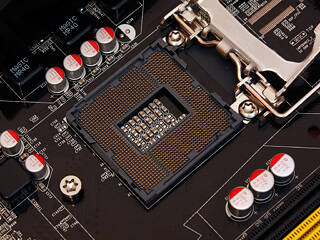 22
22
Foxconn P67A-S Intel P67 Preview Review
Value & Conclusion »A Closer Look
The socket looks very much like the 1156 parts with two seperated pin "chambers" and the holes for a CPU cooler are placed in the exact same locations so that you can keep using your existing cooler if it is compatible to Socket 1156 already. The P67 chipset is rather compact and has a laser engraving with various information on there. Foxconn uses thermal tape to transfer the heat from the chipset to the small heatsink. I count five phases for the CPU, which should suffice for most applications.
A little display can show you where the board gets stuck during the boot process with the help of various POST codes. This should make troubleshooting on the Foxconn board much easier and it is good to see such a feature on this unit. Interestingly enough you also have voltage measuring points on the left edge of the board. Such a feature is usually reserved for high-end mainboards and it is interesting to see such a possibility on a board like this.
Foxconn has implemented an AMIBIOS unto the board. Foxconn has also been using that configuration with the Bloodrage X58 boards already.
We can see Foxconn's proprietary chip labeld "FOX 2" located close to the CPU socket. This chip has been around for quite some time - years even. In the past the Fox One has been used to implement overclocking features or control the fan speeds.
Since P67 does not support PCI, a IDT PCIe to PCI bridge chip is used to enable the two PCI slots on the motherboard. Besides that you will find the D720200F1 USB 3.0 controller chip from NEC as Intel has refused to incorporate this new interface into their P67 chipsets.
There is a small IC to the north of the CPU socket. I am not sure what this one is for. It is extremely tiny and I can only read the letters "ON".
A Marvel 88SE6121 chip is used to offer the dual eSATA connectivity along with an IDE port. While it is a good feature to have - just in case, this interface is on the way out.
Both Audio and the Gigabit Ethernet are provided by Realtek chips. The first is an ALC888, a very common 7.1 audio controller, while the other is the RLT8111E.
May 6th, 2024 22:02 EDT
change timezone
Latest GPU Drivers
New Forum Posts
- Cybersecurity - OSINT Software for Linux (3)
- Gigabyte Aorus Elite AX V2 rev 1.1 BIOS update "AMD AGESA V2 1.2.0.B" (5)
- nvflashk - Flash any BIOS to NVIDIA GPUs - Safe board ID bypass up to 4xxx series (241)
- Only some humans can see refresh rates faster than others, I am one of those humans. (201)
- The Official Thermal Interface Material thread (1167)
- RTX 2070 8GB unable to flash (0)
- Update on the whole PC rebooting issue. There was an extra standoff in the case, but now it's crashing even more (3)
- What's your latest tech purchase? (20449)
- Battery swap for cyberpower UPS (61)
- Silly question about upcoming CPU Upgrade (9)
Popular Reviews
- Finalmouse UltralightX Review
- Cougar Hotrod Royal Gaming Chair Review
- Meze Audio LIRIC 2nd Generation Closed-Back Headphones Review
- Upcoming Hardware Launches 2023 (Updated Feb 2024)
- ASRock NUC BOX-155H (Intel Core Ultra 7 155H) Review
- Corsair iCUE Link RX120 RGB 120 mm Fan Review
- AMD Ryzen 7 7800X3D Review - The Best Gaming CPU
- ASUS Radeon RX 7900 GRE TUF OC Review
- Montech Sky Two GX Review
- HYTE THICC Q60 240 mm AIO Review
Controversial News Posts
- Intel Statement on Stability Issues: "Motherboard Makers to Blame" (248)
- Windows 11 Now Officially Adware as Microsoft Embeds Ads in the Start Menu (167)
- AMD to Redesign Ray Tracing Hardware on RDNA 4 (165)
- Sony PlayStation 5 Pro Specifications Confirmed, Console Arrives Before Holidays (118)
- AMD's RDNA 4 GPUs Could Stick with 18 Gbps GDDR6 Memory (114)
- NVIDIA Points Intel Raptor Lake CPU Users to Get Help from Intel Amid System Instability Issues (106)
- AMD Ryzen 9 7900X3D Now at a Mouth-watering $329 (104)
- AMD "Strix Halo" Zen 5 Mobile Processor Pictured: Chiplet-based, Uses 256-bit LPDDR5X (103)












